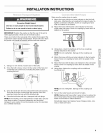
Wash/Rinse Temp
Select a water temperature based on the type of load you are
washing. Use the warmest wash water safe for fabrics. Follow
garment label instructions.
Warm rinses leave the loads drier than cold rinses. Warm rinses
increase wrinkling. In cold climates, a warm rinse makes the load
more comfortable to handle. Cold rinses save energy.
Temperature Guide
Wash Water Temperature Suggested Fabrics
HOT Whites and pastels
Heavy soils
WARM Bright colors
Moderate to light soils
COLD Colors that bleed or fade
Light soils
In wash water temperatures colder than 60°F (15.5°C), detergents
do not dissolve well. Soils may be difficult to remove.
Auto Temp Control
ATC (Auto Temp Control) electronically senses and maintains a
uniform water temperature. ATC regulates incoming hot and cold
water. The ATC is automatically turned On when a cycle is
selected. See "Preset Cycle Settings" in "Cycles."
• ATC ensures consistent cleaning.
• ATC works for the wash temperature with Hot/Cold, Warm/
Warm, Warm/Cold, and Cold/Cold settings.
• ATC works for the Warm rinse setting by regulating the water
temperature at approximately 104°F (40°C).
• The Cold rinse temperatures depend on the cold water at
your faucet.
Refer to this chart for suggested load types and their corresponding cycles. Listed to the right are the options available within each of i! i
these washer cycles.
CYCLE SUGGESTED LOAD TYPE PREWASH RINSE EXTENDED SPIN .....
OPTIONS
Whitest Whites Soiled white fabrics v' v' v'
Heavy Duty Heavily soiled underwear, towels, shirts, etc., made of _/ v' v'
cotton
Normal/Casual Normally soiled blouses, shirts, overalls, etc., made of v' v' v'
polyester, nylon, cotton, linen, or cotton blends
Delicate Curtains and delicate clothing, dresses, skirts, shirts v' v'
and blouses
Handwash Fabrics made of silk, special-care items marked as v'
"Handwashable"
LAUNDRY TIPS
Preparing clothes for washing
Follow these recommendations to help you prolong the life of
your garments.
• Use only High Efficiency detergents. The package for this type
of detergent will be marked "HE" or "High Efficiency." This
wash system, along with less water, will create too much
sudsing with a regular non-HE detergent. Using regular
detergent will likely result in washer errors, longer cycle times,
reduced rinsing performance, and may result in component
failures and noticeable mold or mildew. HE detergents are
made to produce the right amount of suds for the best
performance. Follow the manufacturer's instructions to
determine the amount of detergent to use.
Close zippers, snaps, and hooks to avoid snagging other
items. Remove pins, buckles, and other hard objects to avoid
scratching the washer interior. Remove non-washable trim
and ornaments.
• Empty pockets and turn them inside-out.
• Turn down cuffs; brush away lint and dirt.
• Turn synthetic knits inside-out to avoid pilling.
• Tie strings and sashes so they will not tangle.
• Mend tears, loose hems, and seams.
• Treat spots and stains.
• Stained or wet garments should be washed promptly for best
results.
• Mix large and small items, avoid washing single items, and
load evenly.
• Wash small items such as infant socks in mesh garment
bags. It is recommended that more than one garment bag be
used and that each garment bag be filled with equal amounts
of material.
17


















